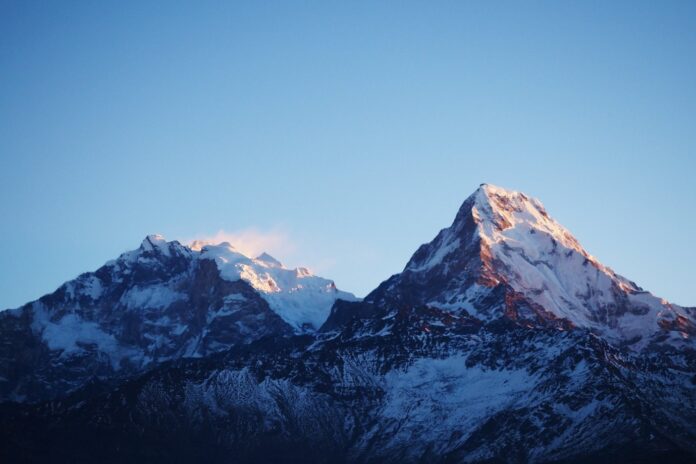The Annapurna region is filled with a vast array of natural and cultural diversity. Hence Annapurna trekking in Nepal is one of the most famous adventure activities in the world. Since the region is rich in cultural legacy along with ethnic diversity the trek takes you through various monasteries, local settlements, and many more locations that reflect the culture and history of the region.
The Annapurna region doesn’t fail to mesmerize its visitors with majestic snowcapped mountains, lush landscapes, ethnic villages, and vibrant religious communities that display the distinct blend of Tibetan and Nepali cultures. Annapurna trekking is a haven for naturalists as it boasts flora fauna and forest but it is also a place for anyone looking for a spiritual experince. Hence the region caters to trekkers and visitors with a wide variety of preferences. Annapurna trekking is not a tough trek in itself. It is a moderate trek in comparison to other trekking routes in Nepal. So this trek is suitable for every trekker from novice to professional.
As you trek through the routes of the Annapurna region you will get a deep understanding of the diverse population and culture in the distant Himalayas of nepal. Understanding the customs, interacting with the locals, and participating in the various cultural activities will foster a sense of respect among the people. These interactions and ventures in the deep valleys of the Himalayas will establish a deep connection spiritually mentally and physically which will furthermore create an immersive experience for the trekkers.
Understanding the history and culture of the Annapurna region
The Annapurna region is a historically and culturally rich location. Here we list down some aspect that reflects the history and culture of the region so make sure you read until the end.
Religion and belief
People in this region follow Buddhism and Hinduism religions these religions are scattered throughout the region. Annapurna trekking in nepal will take you along the trail where one can recognize sites like Buddhist monasteries, prayer flags dancing in the breeze, and finely carved mani walls, which are stone walls etched with mantras. Hindu temples and shrines honoring gods like Lord Shiva and Goddess Annapurna are also common, illustrating the region’s diverse religions. Alongside the sacred locations nestled in the mountains, the Annapurna trekking in nepal also takes you through many customs and traditions that reflect the religious beliefs of people of their respective religions. Hence the Annapurna region allows visitors to delve deeper into the numerous, aesthetically distinct sublayers that make up the Nepali cultural tapestry.
People and Culture
The Annapurna Trekking in nepal offers breathtaking natural beauty along with ethnic locals and their dynamic culture. Exploring ethnic cultures at historical places along the Annapurna Circuit offers a greater understanding of Nepal’s vast cultural diversity. The trekkers will cross various deep valleys and settlements of ethnic groups like Thakalis, Gurungs, Magars, Tamangs, Brahmins, and Chhetris.

All of these ethnic groups have their distinct customs and traditions. Hence trekkers can foster a deeper connection with the locals and indulge in the culture and tradition of the settlements of the region which have been passed down from generation to generation. These warm and friendly people are very hospitable. Trekkers can be expected to be welcomed into their homes to try traditional delicacies and accommodations with open arms. Most tea houses in the region are also operated by the local people which is scattered around the area.
These teahouses are usually pitstops for visitors and trekkers during their Annapurna trekking. These tea houses offer an array of amenities along with top-notch hospitality. Furthermore, since these teahouses are locally owned visitors can also build a sense of companionship with the owner of the teahouse which enhances the trek and gives a deeper and meaningful insight into the people and their culture. Hence the Annapurna trekking in nepal is an adventure along with a learning experience that also teaches you about spiritual ideas and sustainable living techniques of the Himalayas.
Read more Top HVAC Solutions in Las Vegas: Keeping You Cool and Comfortable
Festivals
Festivals are one of the main aspects of the Annapurna region which reflect the region’s vibrant culture and tradition. Visitors and trekkers can enhance their understanding of the Himalayan culture tradition and history by indulging and observing these distinct festivals.
Hence the Annapurna trekking in nepal isn’t just an adventurous and culturally rich journey but also an educational one as trekkers can grasp and understand the purpose of the particular festival and the historical or religious reason behind it. Festivals like Dashain and Tihar are celebrated throughout the region.
Some festivals like Lhosar, Ghatu Naach, and Sakela are celebrated by the Gurungs, Magars, and Tamangs communities of the region respectively. Festival plays a huge role in the preservation of culture in the region. The participation of the visitors also helps the local economy. The sense of communal harmony and bonding with the locals during these festivals magnify the Annapurna trekking experience to a greater degree.
Historical legacies
The Annapurna region holds a lot of history in its mountains and valleys. The mountain Annapurna itself is named after the goddess of food and harvest “Maa Annapoorna”
The region lies in the northwest and central part of nepal and stretches from the Marshyangdi River up to the Kali Gandaki River. The history of the Annapurna Base Camp Trek dates back thousands of years. It was a route that was used for trade between nepal and Tibet. The region also served as a route to the Annapurna temple which is located at the Annapurna sanctuary which is a sacred site for Hindu and Buddhist pilgrims. The region was originally restricted and only made accessible to tourists in recent times.
Other cultural highlights
Nepal’s traditional way of life has persisted throughout history and is still ingrained in the nation’s culture. They allow visitors to delve deeper into the numerous, aesthetically distinct sublayers that make up the Nepali cultural tapestry. Hence some of the highlights of the Annapurna trekking are listed below.
- Discover delicious culinary foods in rural areas. Savor traditional Nepalese cuisine and regional specialties made using ingredients that are obtained locally and freshly. Savor traditional foods such as momo, Gundruk, Thakali thali, and Dal Bhat which is the national food of nepal.
- Participate in cultural events and workshops, including demonstrations of handicrafts, cooking classes, and traditional dance performances, hosted by local ethnic communities.
- Make your journey across the trail where people are still using generations-old farming methods. Observe the beautiful terraced fields carved into the mountainside.
- Enhance the experience with simple conversations in the local tongue. So learn and gain proficiency in a few essential phrases and salutations in the regional dialects or Nepali language to demonstrate respect and admiration for their way of life.
- Make pit stops in villages and local settlements to gain a better understanding of the customs and culture of the area by conversing with people and posing inquiries. The process creates cross-cultural ties between the trekkers and local folks.
- The traditional clothes and dress of the Annapurna region’s inhabitants reflect the vibrant tapestry. Wear vibrant traditional clothes that highlight the depth of Nepal’s cultural heritage.
- Discover the friendly hospitality of guesthouses and tea houses. Talk to the proprietors of teahouses, porters, guides, and other trekkers from different parts of the world to share stories and religious and cultural beliefs.
Conclusion
Trekking to Annapurna Base Camp offers a trip through traditional practices and
contemporary adventures, making it an incredibly unique and remarkable experience.
We can comprehend the complex relationship between the region and human existence when we have a better understanding of the various ethnic groups, their customs, and the effects of tourism on the surrounding community.
Through engaging with rural life, enjoying regional cuisine, and experiencing the friendly hospitality of teahouses, you can acquire a deep comprehension of the cultural fabric that endures throughout the journey. Hence the Annapurna Circuit will take you through different facets of ethnic groups, cultural events, and rituals on your own. So if you’re interested in learning more about Nepalese culture. The rich cultural legacy and unspoiled beauty that has remained unchanged for centuries will take you through a once-in-a-lifetime experience. So get ready for a challenge that rewards you with an experience like any other journey.


